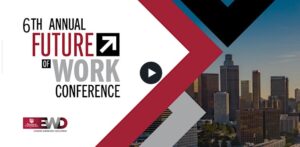
Why Harness Worker ‘Agency’
Measuring how employers value employees is only one element of the workforce development agenda. Another perspective examines how workers value their employers, which, it turns out, may have a bigger impact on current and future employment levels than was previously believed. Businesses that understand and facilitate their worker’s desire for ‘agency’ – the sense of having control over one’s actions and consequences – are more likely to have personnel who enjoy their work and are willing to contribute their valuable assets to share in the company’s growth.
Occupational Options Drive Employee Elections
As the COVID-19 pandemic continues to rearrange how the world works, it is also shifting the relative perspectives – and power bases – of workforce participants at all levels of that strata. These days, workers are commanding – and receiving – more recognition and respect from their workplace, but not through the use of vocal demonstrations or public agitation. Instead, they are asserting their value as a significant corporate asset and not just a commodity to be purchased. Employers who heed and respond to these new declarations of ‘worker agency’ may end up gaining a better workforce and a stronger company in return.
The newly popular opportunity to work remotely is just one of the influences on a worker’s decision about where to work and for whom. Throughout the pandemic, employees compelled to work from home using their personal technology were rewarded not just with an income but also with better control over their time – more agency over their occupational decisions. In many cases, companies continued to receive high-quality workforce performance despite giving up control over where or when those staffers were laboring. As the pandemic began to recede, the opportunity to work remotely became an attractive option for both existing and potential workers and remains so today.
That shift of power in the employee’s favor is having a profound effect on today’s workforce numbers. A 2022 survey revealed that many formerly employed people have voluntarily chosen to remain out of the workforce. Rather than acquiesce to their former work environment, which they found to be either uncomfortable, unfair, or both, they have chosen other methods of maintaining their lifestyle instead of returning to a job that they did not like. Of survey respondents, 36% reported being unemployed or furloughed from their former employment. Of those:
Almost one in five (19%) had adopted the title of ‘homemaker’ to describe their new occupation.
Another 17% had fully retired.
14% were working part-time, while 8% had started their own enterprise.
Notably, only 6% reported turning to some form of schooling.
Remarkably, the majority of these former workers who were intentionally shunning traditional employment opportunities were not financially well off. Almost nine in ten (89%) were earning less than $75,000 per year, and 83% of those were earning less than $50,000 annually. That reality suggests that, at least for some, living a reduced lifestyle because of financial constraints was better than making money doing something they didn’t enjoy doing or working for an employer they didn’t like or respect.
The survey respondents gave several reasons why they weren’t invested in finding full-time employment any time soon (some offered more than one reason):
28% cited ongoing health concerns that prevented them from looking for work.
27% were tending to family matters that would otherwise go unaddressed.
23% said family members were taking up the financial slack created by their unemployment.
Perhaps most relevant to workforce development professionals: over 40% stated that the wages in their industry weren’t competitive for their skill set and that they weren’t going to look until that circumstance improved in their favor.
While the survey itself was just a small sampling of the general unemployed population, it does reveal at least some of the very real and relevant factors that are impeding the country’s post-COVID economic recovery. Workers who can’t find employment that gives them both job and personal satisfaction won’t be contributing to the economic recovery effort.
Employer Options Encourage Economic Engagement
According to Deloitte, only 17% of business leaders feel confident that their companies are prepared to provide their workers with the employment standards now expected by many of the country’s unemployed. While most (84%) of the respondents to that 2023 survey acknowledged that ‘worker agency’ is essential to corporate success, thus far, they had only looked at or initiated the three major employee satisfaction practices that had arisen during the COVID-19 concern: insufficient compensation, home or office location, and control over working hours.
There are other opportunities and themes for employer/employee relationship exploration available, however, that may also prove fruitful:
Adopt the premise that those who share the corporate success journey should also share corporate success outcomes. For example, adding merit bonuses to compensation practices and instituting an employee profit-sharing program can enhance productivity across the enterprise.
Strategize, develop, and execute programs that support the worker-organization relationship. business leaders can contemplate how the employee’s voice and opinion can improve corporate practices and policies, for example.
Design tracking and monitoring practices to follow newly instituted procedures to embed those more holistic employment satisfaction conventions in place.
Doing nothing in the face of these workforce evolutions could prove disastrous. The global scope of the ‘workforce revisioning’ process suggests that how, when, and where corporate productivity is accomplished is no longer just a C-Suite decision. There are pockets of laborers in almost all countries who are clamoring for both more power and more satisfaction from their occupation, and that may be the new ‘workforce development’ normal.
Here in the U.S., survey responses appear to indicate that a significant proportion of the now-unemployed or under-employed population would rather not work than work at a job they don’t like. If that situation continues, then America will continue to face a critical shortage of workers in its national workforce. Organizations without a sufficient or well-trained workforce aren’t able to maximize their investments, market share, or profits. Reduced corporate productivity results in reduced tax revenues for communities. Employers, companies, and industries should note these concerns and do what they can to remedy their organization’s workforce challenges if they intend to remain in business and compete in the global market.


